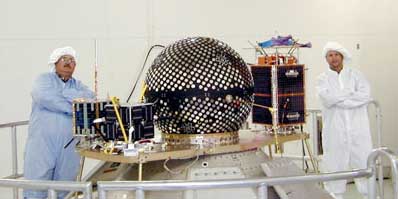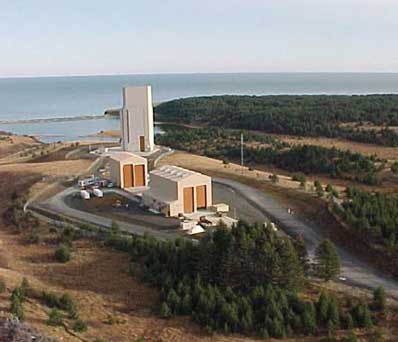
The Kodiak Star Mission
NASA-KSC FACT SHEET
Posted: September 19, 2001

The four satellites of Kodiak Star mounted on the special deck they will ride to space. Photo: NASA
|
In 1998, Kennedy Space Center become the lead center responsible for NASA's acquisition and management of the Expendable Launch Vehicle (ELV) Launch Services Program. The Program, with its vision statement, "Global Leadership in Launch Service Excellence," provides launch services for NASA and NASA-sponsored payloads from launch sites that include Cape Canaveral Air Force Station, Fla; Vandenberg Air Force Base, Calif; Kwajalein Atoll in the Pacific; Wallops Flight Facility, Va; and a new launch complex on Kodiak Island, Alaska.
Athena 1 Kodiak Star Launch
Of particular importance to NASA is the upcoming Kodiak Star Mission, which utilizes a Lockheed Martin Athena 1 launch vehicle. This mission is scheduled for launch in the Fall of 2001 and will be the first orbital launch utilizing the new Kodiak Launch Complex in Alaska. The Kodiak Star Mission will carry four satellites into Earth orbit: the NASA-sponsored Starshine 3, and three satellites sponsored by the Department of Defense Space Test Program (STP): PICOSat, PCSat and Sapphire.
Each satellite has specific orbit requirements, which the Athena 1 vehicle will accomplish by maneuvering into two separate orbits with the STP satellites being released at an altitude of 497 miles (800 km) and Starshine 3 released at an altitude of 310 miles (500 km).
Starshine 3
| |

Starshine 3. Photo: NASA
|
Starshine 3 is a student-built satellite developed by the Rocky Mountain NASA Space Grant Consortium and the Naval Research Laboratory. The satellite is a one-meter optically reflective sphere that weighs 220 pounds (100 kg). Starshine 3 is covered with approximately 1500 aluminum "mirrors" that are one inch each in diameter. These mirrors were machined by technology students in Utah, with the grinding and polishing of the mirrors being accomplished by students in kindergarten through twelfth grade in schools all over the world. Once Starshine 3 is in orbit, students can visually track the satellite with the naked eye. Students will determine the coordinates of Starshine 3 and record their locations on the Starshine Project Internet Web site. The resulting Starshine 3 data will provide scientists with new knowledge about how the Earth's upper atmosphere reacts to fluctuations in the sun's ultraviolet radiation during a sunspot cycle. This knowledge will help NASA improve forecasts of satellite orbit decay that will help astronauts to more precisely perform debris avoidance maneuvers for the international space station and the space shuttle.
Launching Starshine 3 from the Kodiak Launch Complex at a 67-degree inclination will allow students worldwide, including northern latitudes such as Alaska, northern Canada, Scandinavia and Russia, to participate in the project. Worldwide student participation has not been possible on previous Starshine missions launched at lower inclinations from the space shuttle.
Space Test Program-Sponsored Satellites
| |

PICOSat. Photo: NASA
|
PICOSat is built by Surrey Satellite Technology Ltd. in Guildford, United Kingdom. PICOSat's mission is to fly and operate four scientific payloads: Polymer Battery Experiment (PBEX), Ionospheric Occultation Experiment (IOX), Coherent Electromagnetic Radio Tomagraphy (CERTO) and Ultra-Quiet Platform (OPPEX).
PBEX is designed to test the flexible polymer battery for applications to space flight. IOX uses Global Positioning Satellite signals to measure ionospheric properties that impact communications and navigation signals. CERTO measures electron content of the ionosphere with the beacon signal and ground-based receivers. OPPEX demonstrates passive and active vibration control for position-sensitive sensors.
| |

PCSat. Photo: NASA
|
The Prototype Communications Satellite (PCSat) is the first in an intended line of experimental satellites designed, constructed and tested by midshipmen of the United States Naval Academy. PCSat's function is to serve as a position/status reporting and message communications satellite for remote travelers using only hand-held or mobile radios.
PCSat will augment the existing worldwide terrestrial Amateur Radio Automatic Position Reporting System (APRS) by providing links from 90 percent of the Earth's surface not covered by the terrestrial network.

Sapphire. Photo: NASA
|
The Sapphire satellite was built by Space Systems Development Laboratory of Stanford University and will also be operated by United States Naval Academy midshipmen. Sapphire will carry several experiments into orbit including a Beacon Monitoring Experiment, a Tunneling Horizon Detector and a voice synthesizer microchip that will convert text messages into a synthesized human voice to allow it to "speak" to listeners over amateur radio frequencies.
Athena Launch History
The Athena launch vehicle program began in January 1993. The Athena is a core component of the Lockheed Martin Astronautics family of launch vehicles, which also includes the Titan IV, Titan II, Multi-Service Launch System, Atlas II//III, Atlas V and Proton vehicles.
The first successful launch of an Athena I delivered the NASA-sponsored Lewis satellite into orbit from Vandenberg Air Force Base, Calif., on Aug. 22, 1997. The first successful launch of an Athena II carried NASA's Lunar Prospector spacecraft, on a mission study the moon, from Cape Canaveral Air Force Station, Fla., on Jan. 6, 1998. The most recent Athena launch was Sept. 24, 1999, from VAFB, carrying the IKONOS-2 satellite for Space Imaging.
Kodiak Launch Complex (KLC)
KLC is the newest commercial launch complex in the United States, located on Narrow Cape, of Kodiak Island, Alaska, approximately 41 miles south of the city of Kodiak and 250 miles south Anchorage. The Alaska Aerospace Development Corporation (AADC) built the launch complex and also operates it. The advantage to this location is its wide-open launch corridor and an unobstructed down-range flight path. The location is ideal for launching expendable launch vehicles with payloads requiring low-Earth polar or sun-synchronous orbits.

Launch pad at Kodiak. Photo: AADC
|
KLC facilities utilized by the Kodiak Star Mission include a Launch Control and Management Center (LCMC), Payload Processing Facility (PPF), Integration Processing Facility (IPF), Launch Service Structure (LSS) and Launch Pad.
Range, vehicle and spacecraft operations are conducted from the Launch Control Center (LCC) on launch day. The LCC also serves as the administrative and engineering support facility for the Kodiak Launch Complex.
Spacecraft are received, staged, processed and validated in the PPF. The PPF high bay facilities include an airlock and processing high bay. The IPF is a multifunction building for receiving and processing equipment, components and flight hardware. It serves as a receiving, checkout and vehicle stage integration facility.
The LSS and Launch pad are unique facilities that allow the launch vehicle and payload to be readied for launch in an enclosed environment. A 75-ton bridge crane lifts the fairing to the vertical position onto the launch pedestal. After the entire assembly is complete, and just prior to launch, the surrounding service structure is rotated away.

|
 |
 |
 |
Flight data file
Vehicle: Athena 1
Payload: Kodiak Star
Launch date: Sept. 21, 2001
Launch window: 9-11 p.m. EDT (0100-0300 GMT on 22nd)
Launch site: Kodiak Launch Complex, Alaska
Satellite broadcast: GE-2, Trans. 9, C-band

Pre-launch briefing
Launch timeline - Chart with times and descriptions of events to occur during the launch.

Ground track - See the trajectory the rocket will follow during its flight.

Athena vehicle data - Overview of the rocket to be used in this launch.







|

